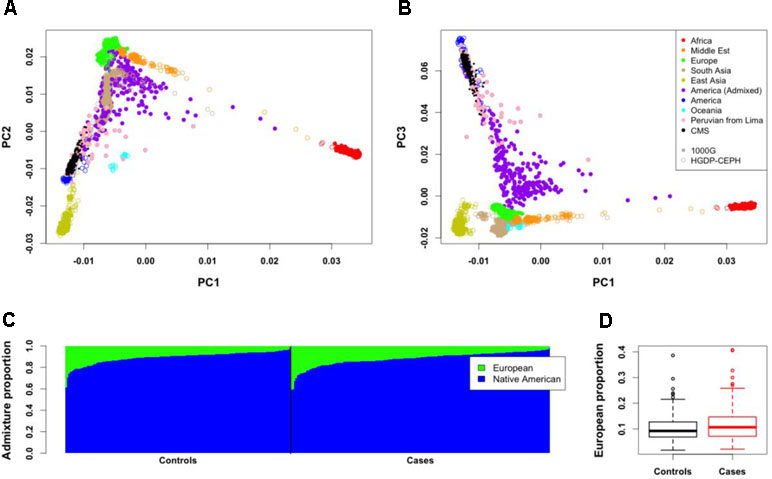4















| Thumbs Up |
| Received: 444 Given: 391 |

¿Qué tan europeos son Perú y Bolivia en promedio? ¿20-30%?















| Thumbs Up |
| Received: 12,362 Given: 11,959 |

More than 75% are indomestizo/amerindian range















| Thumbs Up |
| Received: 12,362 Given: 11,959 |














| Thumbs Up |
| Received: 1,347 Given: 369 |



| Thumbs Up |
| Received: 47 Given: 59 |

That is a lot more amerindian than I would have guessed. Previous studies like this one (https://journals.plos.org/plosgeneti...l.pgen.1004572) gave only 64% amerindian for Peru/Lima (which seemed more accurate to me, but who knows).













| Thumbs Up |
| Received: 815 Given: 233 |















| Thumbs Up |
| Received: 12,362 Given: 11,959 |

Latest peruvian studies have all been very amerindian tbh
https://www.biorxiv.org/content/10.1101/561241v1
https://www.biorxiv.org/content/10.1...ntary-material
Material and methods
Study design & participants
As described previously (1), the data was obtained following institutional IRB guidelines and with informed consent from participants. We collected genotyping data for 4,002 individuals
from 1,769 households in Lima, Peru, using a customized Affymetrix Axiom array as described previously (1). In brief, we designed a ~720K marker array based on exome-sequencing data
from 116 Peruvians in order to optimize for population-specific rare and coding variants. Quality control on the genotypes, phasing and imputation was performed as described previously using
GRCh37 as the reference genome (1).
Figure S3: Global ancestry analysis using ADMIXTURE (K=4). We observed varying levels of European, African, and Asian admixture in the Peruvian population with a median proportion
of Native American, European, African, and Asian ancestry per individual of 0.83 , 0.14 , 0.01 and 0.003 respectively.
https://www.ncbi.nlm.nih.gov/pubmed/31370293
Identification of Main Genetic Causes Responsible for Non-Syndromic Hearing Loss in a Peruvian Population.
Abstract
: Hearing loss (HL) is a common sensory disorder affecting over 5% of the global population. The etiology underlying HL includes congenital and acquired causes; genetic factors are the main cause in over 50% of congenital cases. Pathogenic variants in the GJB2 gene are a major cause of congenital non-syndromic hearing loss (NSHL), while their distribution is highly heterogeneous in different populations. To the best of our knowledge, there is no data regarding the genetic etiologies of HL in Peru. In this study, we screened 133 Peruvian families with NSHL living in Lima. We sequenced both exons of the GJB2 gene for all probands. Seven probands with familial NSHL that remained negative for GJB2 variants underwent whole genome sequencing (WGS). We identified biallelic pathogenic variants in GJB2 in 43 probands; seven were heterozygous for only one allele. The c.427C>T variant was the most common pathogenic variant followed by the c.35delG variant. WGS revealed three novel variants in MYO15A in two probands, one of them was predicted to affect splicing and the others produce a premature stop codon. The Peruvian population showed a complex profile for genetic variants in the GJB2 gene, this particular profile might be a consequence of the admixture history in Peru.
https://www.frontiersin.org/articles...019.00690/full
The Genetic Architecture of Chronic Mountain Sickness in Peru
Chronic mountain sickness (CMS) is a pathological condition resulting from chronic exposure to high-altitude hypoxia. While its prevalence is high in native Andeans (>10%), little is known about the genetic architecture of this disease. Here, we performed the largest genome-wide association study (GWAS) of CMS (166 CMS patients and 146 controls living at 4,380 m in Peru) to detect genetic variants associated with CMS. We highlighted four new candidate loci, including the first CMS-associated variant reaching GWAS statistical significance (rs7304081; P = 4.58 × 10−9). By looking at differentially expressed genes between CMS patients and controls around these four loci, we suggested AEBP2, CAST, and MCTP2 as candidate CMS causal genes. None of the candidate loci were under strong natural selection, consistent with the observation that CMS affects fitness mainly after the reproductive years. Overall, our results reveal new insights on the genetic architecture of CMS and do not provide evidence that CMS-associated variants are linked to a strong ongoing adaptation to high altitude.
















| Thumbs Up |
| Received: 12,362 Given: 11,959 |

Here the results of the 4 studies i posted in this thread
https://cancerres.aacrjournals.org/c...72.CAN-19-3659
The estimated average IA ancestry was 76%, the average European ancestry 18%, the average African ancestry 4%, and the average East Asian ancestry 2%
https://www.biorxiv.org/content/10.1101/561241v1
We observed varying levels of European, African, and Asian admixture in the Peruvian population with a median proportion of Native American, European, African, and Asian ancestry per individual of 0.83 , 0.14 , 0.01 and 0.003 respectively.
https://www.ncbi.nlm.nih.gov/pubmed/31370293
On average, the fraction of American Indian ancestry in Peruvians was the highest with the mean 76.9% (SD = 16.9). The EU, AF, and EA ancestry proportions were split, with the mean values 18.7% (SD = 13.8), 2.9% (SD = 4), and 1.5% (SD = 7.8), respectively
https://www.frontiersin.org/articles...019.00690/full
Around half of the individuals (160 individuals) have less than 10% European ancestry, while 20% showed more than 15% European ancestry (58 individuals, including 28 individuals with more than 20%). The proportion of European admixture in unrelated CMS cases (11.59 ± 6.37%; median = 10.25) tended to be higher than in unrelated controls (10.96 ± 5.89%; median = 9.09); however, this difference was not significant













| Thumbs Up |
| Received: 1,347 Given: 369 |
There are currently 1 users browsing this thread. (0 members and 1 guests)
 Latin America
Latin America
 Brazil
Brazil
 Latin America
Latin America
 Latin America
Latin America
 Latin America
Latin America
Bookmarks